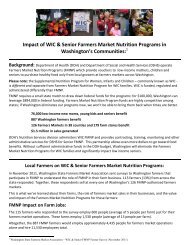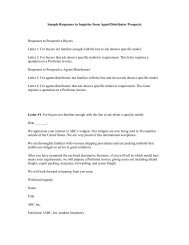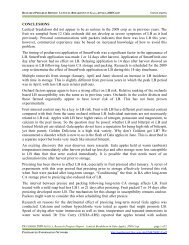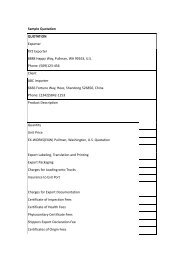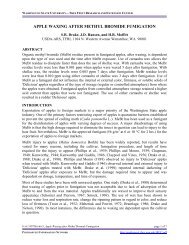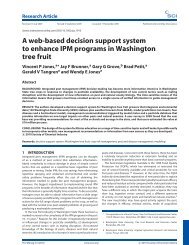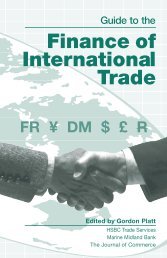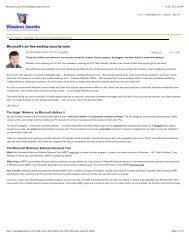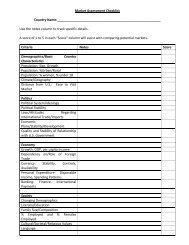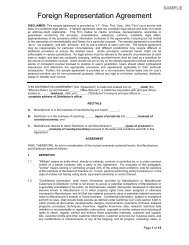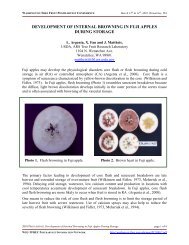Cover Crops for Orchards - Tree Fruit Research & Extension Center
Cover Crops for Orchards - Tree Fruit Research & Extension Center
Cover Crops for Orchards - Tree Fruit Research & Extension Center
Create successful ePaper yourself
Turn your PDF publications into a flip-book with our unique Google optimized e-Paper software.
<strong>Cover</strong> <strong>Crops</strong> <strong>for</strong><br />
<strong>Orchards</strong><br />
David Granatstein<br />
WSU CSANR<br />
Wenatchee, WA<br />
In collaboration with Joan Davenport,<br />
Elizabeth Kirby, Michel Wiman, Amos<br />
Kukes, Kent Mullinix
Apple Root Density<br />
Neilsen and Neilsen, 2003
Mini Tatura Trellis on M.9<br />
Washington<br />
Standard System<br />
Herbicide strip, grass alley
Orchard <strong>Cover</strong> <strong>Crops</strong><br />
<strong>Cover</strong> crops affect:<br />
• Weeds<br />
• Soil and orchard temperature<br />
• Soil moisture, physical properties<br />
• Soil C, N, other nutrients (root exudates)<br />
• Soil biology, food web<br />
• <strong>Tree</strong> per<strong>for</strong>mance<br />
• Pests (insect, disease, rodents)<br />
• N fixation (legumes)
<strong>Cover</strong> Crop Choices<br />
Age of orchard, rootstock<br />
<strong>Fruit</strong> harvest date<br />
Irrigation system, water<br />
Alley, tree row, ‘Sandwich’<br />
Legume, grass, broadleaf<br />
Species, cultivar<br />
Annual or perennial<br />
Nematode host?<br />
Insect pest host?<br />
Mulch?
Orchard Floor Management Review<br />
Microclimate:<br />
• soil temperature inverse to the amount of herbage<br />
or mulch<br />
• plant mulch dampens extremes of daily soil<br />
temperature<br />
• plant cover reduces minimum air temperature by<br />
0.5-1.0 o C<br />
• bare, compacted wet soil raised minimum air<br />
temperature by as much as 2 o C<br />
• effects on humidity and disease? Russet?<br />
(Skroch & Shribbs, 1986)
Orchard Floor Management Review<br />
Soil quality:<br />
• avoid cultivation<br />
• favorable soil effects: legumes > grass > mulch ><br />
bare ground > cultivation<br />
Water:<br />
• soil moisture availability: mulch > bare soil ><br />
minimal cultivation > grass > legumes ><br />
continuous cultivation<br />
• mowing decreases water use<br />
(Skroch & Shribbs, 1986))
WA Peach<br />
5 yr old trees<br />
• Orchard grass – mowed late May<br />
• Alfalfa – mowed late May, mid-summer<br />
• Rye (winter cc) – disked late May, summer cult<br />
• Vetch (winter cc) - disked late May, summer cult<br />
• Mulch under tree<br />
• Herbicide<br />
• Alfalfa delayed maturity<br />
• Highest yield with mulch<br />
• N, water effects<br />
(Proebsting, 1958)
MI Tart Cherry<br />
<strong>Cover</strong> crop mix – crimson cl, annual ryegrass/hard<br />
fescue, berseem clover; no herbicides, mowed,<br />
irrigated<br />
• Highest yields – mulch<br />
• <strong>Cover</strong> crops, compost improved soil quality<br />
• Fewest pest mites in cover crop; beneficial mites<br />
all year in red clover<br />
• <strong>Cover</strong> crop + fertigation was among most<br />
profitable<br />
• Nitrate leaching – most in season-long herbicide<br />
(Edson et al., 2003)
MI Tart Cherry<br />
(Edson et al., 2003)
NZ Apple<br />
• 8 yr old apple trees<br />
• Several species mixes<br />
• Fixed N can replace harvest and leaching<br />
removal ( 15 N method)<br />
Annual N fixed by understory<br />
kg N/ha<br />
Red clover 33-84<br />
Herb ley 12-105<br />
(Goh et al., 1995)
NZ Apple<br />
• Legumes – increased fruit N, delayed<br />
maturity; lower Brix and firmness than grass<br />
• Mow and blow provided large inputs of<br />
nutrients; increased tree growth and fruit<br />
yield; did not increase fruit disorders<br />
Mow Mow & blow<br />
pH 6.1 6.8<br />
N (%) 0.24 0.33<br />
P (ppm) 28 37<br />
K (ppm) 6 30<br />
Ca (ppm) 12 15<br />
Mg (ppm) 18 35<br />
(Marsh et al., 1996)
Legume <strong>Cover</strong> <strong>Crops</strong><br />
Rio Negro, Argentina<br />
5 yr old apple; 3.2 m drive alleys, mowed twice a<br />
year<br />
Leaf N TCSA <strong>Fruit</strong> Yield<br />
(%) (cm 2 ) (tons/ha)<br />
Strawberry Clover 1.98 a 113 a 54 a<br />
Alfalfa/fescue 1.85 b 108 a 58 a<br />
Vetch 2.00 a 105 a 57 a<br />
Control 1.86 b 94 b 45 b<br />
2 tons/ha 5-5-5 fertilizer<br />
(Sanchez et al., 2007)
WA - White clover<br />
living mulch<br />
• In-row<br />
• Recycles P, K<br />
• Root N contributions,<br />
but N fix suppressed<br />
• Suppresses weeds<br />
• Saves water Fall-planted Dwarf white clover
Grow Your Own N<br />
Nitrogen release over 3 weeks from ambient<br />
soil with and without clover, root exclusion<br />
tubes, and tube covers.<br />
Soil Nitrate<br />
kg N/ha<br />
100<br />
80<br />
60<br />
40<br />
20<br />
0<br />
A B C D E F<br />
7/24/2001<br />
7/32/2001 7/31/2001<br />
8/7/2001<br />
46% of clover N<br />
mineralized<br />
<strong>Tree</strong> growth,<br />
fruit yield<br />
enhanced<br />
A – control plot; tube + cover; no clover<br />
D – clover plot; tube – cover,<br />
clover clippings added<br />
B – control plot; tube + cover; clover clippings added. E – control plot; no tube<br />
C – clover plot; tube + cover, clover clippings added F – clover plot, no tube
Late summer 2000 Early spring 2002<br />
Rodents – the weak link <strong>for</strong> clover.
Vole Trail Length<br />
WA IMM Trial, Winter 05/06<br />
(Winter 06/07, too few to analyze)<br />
trail length (cm/m 2 )<br />
350<br />
300<br />
250<br />
200<br />
150<br />
100<br />
50<br />
Other living<br />
mulches<br />
Galium (sweet<br />
woodruff)<br />
0<br />
LML<br />
LMNL<br />
SWL<br />
SWNL<br />
WC<br />
CTL<br />
WW<br />
11/05 trails 2/06 trails
Sweet Woodruff<br />
(Galium odoratum)<br />
Wenatchee area<br />
Thyme
Mow and Blow Alley <strong>Cover</strong> Crop
2008 Trial – Qunicy, WA<br />
• Legumes direct seeded in drive<br />
alley (4’ swath) – May 19<br />
• Alfalfa cv. Radiant<br />
• Jumbo Ladino white clover<br />
• Kura clover<br />
• Birdsfoot trefoil cv. Norcen<br />
• SPRAY or NO SPRAY prior to<br />
seeding<br />
• Mow and blow be<strong>for</strong>e apple<br />
harvest<br />
No-till drill
Alfalfa after<br />
seeding
Drill - 8” spacing;<br />
narrower would<br />
be better<br />
Single pass<br />
Double pass
Be<strong>for</strong>e mowing<br />
Alfalfa tractor<br />
Alfalfa no tractor
Year 1<br />
Spray<br />
Ladino<br />
clover<br />
No spray
Ladino Clover – May, Yr 2
Alfalfa – May, Yr 2
Mow and Blow<br />
Legume residue in tree row after mow and blow
Legume Biomass<br />
(Yr 2, 2009, 4 cuttings)<br />
Biomass (DM kg/ha)<br />
1200<br />
1000<br />
800<br />
600<br />
400<br />
200<br />
0<br />
Alfalfa Trefoil Ladino Kura Grass<br />
% N of DM 4.1% 3.4% 3.9% 3.1% 2.3%<br />
27-May 1-Jul 10-Aug 1-Oct
Effect of Pre-seeding<br />
Treatment on Biomass<br />
Sum of 8/08, 7/09,<br />
8/09 cuttings<br />
Legume only, 7/09<br />
Sprayed Unsprayed Sprayed Unsprayed<br />
- - - - - - - - - Dry matter (kg/ha) - - - - - - - -<br />
Alfalfa 759 a 685 a 157 a 105 b<br />
Ladino 701 a 719 a 191 a 131 b<br />
Trefoil 783 a 716 a 141 a 74 b<br />
Kura 476 a 486 a 56 a 18 a
Year 3, 2010<br />
Alfalfa<br />
Trefoil<br />
39 days after mowing
<strong>Cover</strong> Crop Biomass, Yr 3<br />
Morgan Orchard, <strong>Cover</strong> Crop Biomass 2010- Spray<br />
2000<br />
1800<br />
1600<br />
Biomass (DM kg/ha)<br />
1400<br />
1200<br />
1000<br />
800<br />
600<br />
400<br />
200<br />
0<br />
Alfalfa Trefoil Ladino Kura Grass<br />
6-May 14-Jun 12-Jul 24-Aug 24-Sep
3000<br />
Morgan Orchard<br />
Cumulative <strong>Cover</strong> Crop Biomass<br />
<strong>Cover</strong> Crop Biomass, 2008-10<br />
2500<br />
Biomass DM (kg/ha)<br />
2000<br />
1500<br />
1000<br />
500<br />
0<br />
Alfalfa Grass Kura Ladino Trefoil Alfalfa Grass Kura Ladino Trefoil<br />
Spray<br />
2008 2009 2010<br />
No spray
100<br />
90<br />
Spray<br />
No Spray<br />
Morgan Orchard 2008-10, Kura clover<br />
Kura clover<br />
100<br />
90<br />
Spray<br />
No Spray<br />
Morgan Orchard 2008-10, Alfalfa<br />
Alfalfa<br />
80<br />
80<br />
<strong>Cover</strong> (%)<br />
70<br />
60<br />
50<br />
40<br />
30<br />
Ground <strong>Cover</strong> (%)<br />
70<br />
60<br />
50<br />
40<br />
30<br />
20<br />
20<br />
10<br />
10<br />
0<br />
June - Oct<br />
2008<br />
May - Oct<br />
2009<br />
April - Aug<br />
2010<br />
0<br />
June - Oct<br />
2008<br />
May - Oct<br />
2009<br />
% <strong>Cover</strong> of Legumes in Drive Alley<br />
April - Aug<br />
2010<br />
100<br />
90<br />
80<br />
Spray<br />
No Spray<br />
Morgan Orcahrd 2008-10, Birdsfoot trefoil<br />
Trefoil<br />
100<br />
90<br />
80<br />
Morgan Orchard 2008-10, Ladino clover<br />
Ladino clover<br />
70<br />
70<br />
<strong>Cover</strong> (%)<br />
60<br />
50<br />
40<br />
<strong>Cover</strong> (%)<br />
60<br />
50<br />
40<br />
30<br />
30<br />
20<br />
20<br />
Spray<br />
No Spray<br />
10<br />
10<br />
0<br />
0<br />
June - Oct<br />
2008<br />
May - Oct<br />
2009<br />
April - Aug<br />
2010<br />
June - Oct<br />
2008<br />
May - Oct<br />
2009<br />
April - Aug<br />
2010
Grower Application<br />
• Grafted ‘Fuji’ Young apple block<br />
• Seeded mid May of 2010<br />
• Direct seed drill directly into existing vegetation<br />
of grasses and weeds (flailed be<strong>for</strong>e seeding)<br />
-- double pass, high seeding rate<br />
• Excellent establishment; ~7’ swath<br />
Alfalfa<br />
White clover<br />
Photos June 16, 2010
Direct-seeded Alfalfa<br />
June 23, 2010
Red Clover<br />
Tilled and seeded<br />
June 14, 2010
N Contribution<br />
Biomass<br />
N 2009<br />
Soil PRS<br />
2009<br />
Ave. Dry<br />
Matter*<br />
2009<br />
Tissue N<br />
Ave. N<br />
Added<br />
(lb N/ac) (ppm NO 3 -<br />
N)<br />
(ton/ac/yr) (%) (lb N/ac/yr)<br />
Alfalfa 38 251 3.56 4.11 46.9<br />
Trefoil 26 179 3.60 3.40 39.2<br />
Ladino 25 173 2.62 3.92 32.8<br />
Kura 14 132 2.72 3.07 26.7<br />
Grass 15 103 3.28 2.30 24.2<br />
*Ave. 2009 and 2010. Yield on a full acre basis; actual strips are 0.16 of<br />
area (2.2’ strip)
Economics<br />
Costs per acre of orchard, 4’ swath<br />
Herbicide 7.15<br />
Tractor/sprayer 14.85<br />
Tractor/seeder 29.70<br />
Seed 32.00<br />
Total 83.90<br />
Planting good <strong>for</strong> at least 5 yr - $21/yr cost<br />
Alfalfa – 3.5 ton/ac/yr @ 4% N = 280 lb N<br />
Width N content Fert. Value a<br />
5’ 101 $71<br />
4’ 81 $57<br />
3’ 59 $41<br />
Over 4 yr, $84 cost / 130 lb N b = $0.65/lb<br />
a<br />
Estimate N fertilizer at $0.70/lb<br />
b<br />
40% avail., accounting <strong>for</strong> Nmin (50-70%), losses<br />
[ 4’ swath, 81 lb N/yr x 4 yr x 0.4 avail = 130 ]
Sampling<br />
Percent cover<br />
Point intersect – stiff wire with 20 pts; place at<br />
45 o to seeding rows; at least 3 representative<br />
spots per plot<br />
Biomass<br />
Quadrat frame – 3-4 representative samples per<br />
plot; cut at mower height; dry, weigh; convert to<br />
lb/ac DM; can weigh wet sample first <strong>for</strong><br />
moisture content estimate and future wet basis<br />
sampling
See OSU cover crop<br />
sampling instructions
Sampling<br />
Nitrogen<br />
Ideal – C,N analyzer, by combustion<br />
Mow and Blow trial, Year 1 Tissue N<br />
% N C:N<br />
Alfalfa 4.06 10.6<br />
Ladino 3.77 11.2<br />
Trefoil 3.36 13.0<br />
Kura 2.83 14.9<br />
Grass 2.15 18.8<br />
Non-legume 2.32 17.7
Sampling<br />
Nitrogen<br />
Ideal – C,N analyzer, by combustion<br />
Total N analysis – reported as %N; e.g. alfalfa 4.11%<br />
N content = 0.0411 x 7120 lb/ac DM = 293 lb N/ac<br />
Need to adjust <strong>for</strong> area – 4’ strip, 14’ row spacing;<br />
4/14 = 0.2857 x 293 = 83.6 lb N/ac of orchard<br />
Need to adjust <strong>for</strong> N mineralization<br />
Get C:N from tissue test e.g. alfalfa 10.6<br />
83.6 lb x 0.40 = 33 lb avail N/ac orchard
http://smallfarms.oregonstate.edu/calculator
100<br />
100<br />
PAN (% of cover crop total N)<br />
80<br />
60<br />
40<br />
20<br />
0<br />
-20<br />
-40<br />
-60<br />
Vetch + Phacelia Mix<br />
Vetch + Oat Mix<br />
28 d<br />
1 2 3 4<br />
1 2 3 4<br />
<strong>Cover</strong> crop mix total N (% of dry wt)<br />
70 d<br />
80<br />
60<br />
40<br />
20<br />
0<br />
-20<br />
-40<br />
-60<br />
Equation: Vigil and Kissel (1991) SSSAJ 55:757<br />
Courtesy: N. Andrews
Could perennial cover crop roots contribute<br />
more available nitrogen?<br />
Residues on surface, not incorporated.<br />
After 40 days surface applied legumes<br />
provided about 20% of the nitrogen provided<br />
by incorporated legumes.<br />
Orchard floor PAN release is probably lower<br />
than calculator estimates.<br />
Less control over timing of PAN release, e.g.<br />
decomposition slower on dry surface.<br />
Courtesy: N. Andrews
Material<br />
C/N<br />
Hairy vetch tops 10<br />
Hairy vetch roots 25-30<br />
Break even point <strong>for</strong> short term N- ~20<br />
mineralization<br />
Adapted from Kuo et al (1997). Soil Science Society of America Journal, 61:<br />
1392-1399.<br />
Courtesy: N. Andrews
Perennial <strong>Cover</strong> <strong>Crops</strong><br />
– mowed, left on surface<br />
• Legume C/N ~10-15<br />
• Cereal C/N ~ 20-40<br />
• Mixtures~ 15-25<br />
• Suggests that orchard<br />
floor residues may<br />
lose 0-5% of the total<br />
%N as NH 3<br />
Dutch lab research, 37 day duration.<br />
Ruijter et al (2010). Atmospheric Environment 44, 3362-3368.<br />
Courtesy: N. Andrews
What we learned so far …<br />
• Need multiple years to assess species;<br />
many novel species to test<br />
• Shade, traffic affecting growth<br />
• Spraying out grass helped, but all<br />
legumes had reasonable stands;<br />
compensate with double pass, higher<br />
seed rate<br />
• Need greater growing surface to boost<br />
N contribution; net ~3’ with tires<br />
• Combinations ? Alfalfa + ladino +<br />
kura?<br />
Thanks to USDA Organic <strong>Research</strong><br />
Special Grant <strong>for</strong> funding.
Resources<br />
UC Davis SAREP<br />
http://www.sarep.ucdavis.edu/ccrop/<br />
- <strong>Cover</strong> Cropping in Vineyards<br />
Midwest <strong>Cover</strong> <strong>Crops</strong> Council<br />
http://www.mccc.msu.edu/<br />
USDA SARE Program<br />
http://www.sare.org/<br />
- Managing <strong>Cover</strong> <strong>Crops</strong> Profitably<br />
WSU<br />
- EB 2010 – <strong>Cover</strong> <strong>Crops</strong> <strong>for</strong> PNW Vineyards<br />
- Orchard floor management<br />
http://www.tfrec.wsu.edu/pages/organic/Orchard_Floor




